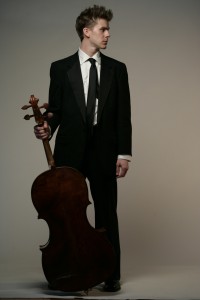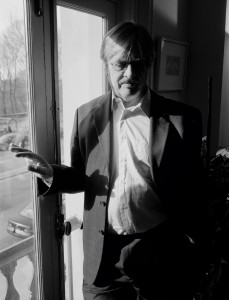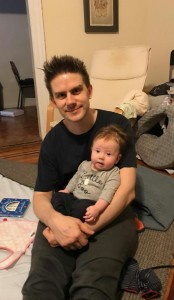By Zach Sheets
A few days ago, I had the chance to chat with Chris Gross about the upcoming iNSIDE Out concerts on January 18th and January 20th at the Flea Theater. Our conversation touched on the music for this weekend, Chris’ vision for the iNSIDE Out series, on being a new father, and on how we listen to a piece of music we’re not familiar with.
ZS: I guess a good place to start would be if you could share about the history of iNSIDE Out. It began with the Roger Smith Hotel series, right? Could you share how things got started—and what your vision is for now and for the future?
 CG: The series started in 2007 or 2008 with a string quartet I was in, but it migrated to Talea at a certain point because we want to do more new music and more ensemble collaborations. Essentially, the vision remained the same, and, in a way, I think it remains the same today.
CG: The series started in 2007 or 2008 with a string quartet I was in, but it migrated to Talea at a certain point because we want to do more new music and more ensemble collaborations. Essentially, the vision remained the same, and, in a way, I think it remains the same today.
Basically, it’s a chance for an audience to explore a particular work, composer, or “theme”. iNSIDE Out tries to do this in a way that is “telescopic”: It’s about looking at something closely but it’s also about setting up situations and asking questions so that the work becomes personally meaningful to each person. It should allow them to hear more fully and should provoke thoughts or personal reflections as a result.
This is not a lecture series. It’s not for the performers to stand up and tell the audience information. Rather, we try to create ways for the audience to respond to the work on their own terms and to find ways for it to become meaningful for them.
The Thursday program, for example, is all about homages. Musical homage has played a role in classical music throughout history, from the very beginning. I’ve been thinking a lot about what it means to make an homage, and, more generally, what are the ways that we honor those who have come before us? How does that process shape who we are as people?
It’s about using the works as a chance to explore the theme more broadly: thinking about how each person might reflect the connections to their own lives or their own identities or their own sense of being.
ZS: As you said, the goal with this series is to find ways that music can be really personally meaningful, and I love that framing. I love putting it in terms of helping each person find these details that are vibrant and exciting to them. So, I’m curious: what are some examples of things that usually make the music you’re performing—or listening to—really personally meaningful for you? And, I guess, to turn the corner on that question: how do you then share that when you’re on stage for an iNSIDE Out?
CG: Well, the hope is—and this is true as a performer or as an audience member—that we’re really listening very closely, and noticing what the composer is doing. That might be something really basic in terms of how he or she uses certain materials. Or, it might be something more technical, but it’s always about relating it back to “what am I hearing”—and then relating that to other themes.
So, thinking about Lerdahl’s program for Saturday: his piece is all about time cycles and expanded repetitions of time. That made me think about how we all go through cycles of time in our daily lives, whether it’s day to day, or changing of the seasons. Each day and each week build upon one another.
I’m a new father, so obviously what’s really on my mind is my daughter and her development as a person. When you think about this tiny baby as a new parent, you’re doing these repetitive tasks like feeding and changing diapers and getting them to sleep. It’s really interesting how you’re in this constant rhythm of taking care of this person, but at the same time, each day, each week, each month, you’re seeing more. You’re hearing more from them. They’re becoming more complex, and they’re telling you more about themselves. Obviously this lasts for an entire lifetime.
I think Fred’s piece speaks to that metaphorically. And, as far hearing the piece itself, it’s sort of an interesting experience, I think, because you begin by hearing these little fragments. You hear them repeated several times, and each time you hear more of the story; you hear more elaboration, more complexity, more detail. And, it’s sort of like a kid; you might just hear a hint of a story, and you think, “oh, tell me more about that”, and then you get a little bit more. This piece is very literally that. It’s a very concentrated expression of how we might think about our own ways of living.
I think this would be the same if I were an audience member, since both activities are centered primarily around listening. They feed on each other, you know. My experience with the Lerdahl has made me experience my daily life differently, and vice versa: Reflecting on my experiences of life have changed the way I interpret the Lerdahl.
I think that’s the sign of a great work of art: constantly experiencing something, even if it’s the 50th time. You’re still responding to it differently because you are a different person. And, I’m hoping that some of the questions and points of discussions that come up at the concerts will be interesting to a wide variety of people. Even if you’re completely new to a new music concert or you go to hundreds each year, your response to the music is authentic to you and who you are as a person at that given moment.
ZS: Exactly, beautifully said. I know that some of the best concerts I’ve ever seen are concerts where you get to hear the same work twice, especially when there’s a different framing the second time. For example, the Ensemble InterContemporain came to NYC this fall and did [Pierre Boulez’s] Répons at the Park Avenue Armory. The audience, which surrounded the ensemble, pin-wheeled 180 degrees around the stage before the second performance to hear from a different angle. Is there anything in particular that you hope people will hear differently the second time in the Lerdahl?
CG: Well, part of the decision to play the work twice is simply born out of the impulse that oftentimes a new piece of music is at a disadvantage because it’s not familiar in the way that Beethoven or Mozart is more familiar. And, getting familiar to the sounds, the rhetoric, the rhythms, the material of it… it’s hard. Personally, I can think of times where I heard a piece once and thought I didn’t enjoy it or didn’t get it, but then hearing it again, I was able to get deeper into the work and notice more.
My hope for this concert on Saturday is that it’s not just about hearing it twice and getting more familiar with it through exposure—although that is part of it. Rather, the hope is that we as a group of people—the audience and us as performers—can discuss some of these themes has Fred has decided to focus on, and discuss how they relate to us as people. What is the experience of listening to a piece of music that deals with time and cycles like for each of us?
 And, of course, it’s about gaining insight from Fred himself—from the creator. It’s about learning more of what he was thinking and what his work is about. On all of these things I hope can help people draw their own connections to the piece so that then when they hear it the second time, not only is it more familiar just based on hearing it again, but some of the concepts—the higher level concepts and ways of thinking—are bringing people in and hopefully allowing them to hear more in the piece, hear more for themselves.
And, of course, it’s about gaining insight from Fred himself—from the creator. It’s about learning more of what he was thinking and what his work is about. On all of these things I hope can help people draw their own connections to the piece so that then when they hear it the second time, not only is it more familiar just based on hearing it again, but some of the concepts—the higher level concepts and ways of thinking—are bringing people in and hopefully allowing them to hear more in the piece, hear more for themselves.
ZS: So, if someone wanted to pull on this thread of familiarity even more, and wanted to, for instance, listen to some music in advance of the concert, or learn a little bit more about the works before they came to the concert, what would you suggest that they do? Would it be more interesting—if given a choice—to listen to the works about which the homages were written, or listen to the works themselves to be performed on Thursday? I know you’re going to play recordings of some of the originals during the concert, right?
CG: Well, there will be some of that. In the case of the homages concert, I’m not necessarily assuming that anybody will know the pieces which are being referenced, or the composers or the pieces or the artwork. But, I don’t want it to just be “oh let’s look at the original, and hey, let’s see what the composer did with this”. I still think that one of the things that’s interesting about the homage or the idea of homages is really the act of choosing. Each composer has chosen this very specific person and has elevated him or her out of their own personal history and made them more important: they’ve constructed their own history.
So, I’m really interested in thinking about, well, “why do we choose certain things?” For instance, the first piece—the Knussen—is so directly referential of Purcell, I really do want people to be able to hear that and have that as a frame of reference. But, a different piece, like James Weeks’ Honey Celebration, is very much its own sound world. Its references are much more, shall we say, conceptual and oblique.
If people do want to do listening before, of course I would say “go for it!” Listen to the composers’ pieces; listen to the originals. In the case of Fred Lerdahl’s work, a lot of his ensemble work is about some similar issues. There’s several chamber pieces, one called Time After Time, which has a very similar compositional process. That’s for sextet. Time and Again is also great, and the structure mirrors the cello duo quite closely.
ZS: And, I imagine learning more about the composers would provide a lot of important context, too?
CG: Sure, and, I think the more you know about the creator of a work of art, where it’s music or painting or anything, the more you can make connections to your own aesthetic experience.
I would also really encourage people to think about each theme. With the idea of homage: Who are the people that we honor? How do we do it? How do those choices influence who we are as people?
Everybody’s going to have a different answer. If you’re a composer coming to this concert, your answer might be very musically-based. You might have certain performers or composers who are very meaningful for you. But, if you’re not, I think the process is still similar. So, I would encourage people to think about the different angles or lenses through which you can view these topics.
ZS: Finally, could you say a little bit about what people can expect in terms of the format of the shows? I know the answer, because I’ve seen the production cue-cards, but for anyone who’s thinking about coming: you’ve really created this beautiful interactive environment! As you said, it’s much more than a lecture. Can you summarize a little bit what people can expect for either night?
CG: Sure! I think an audience that comes to an iNSIDE Out series should be prepared that they will be asked to contribute. I hope it won’t be scary, and I would never put anybody on the spot! But, it’s not the kind of series which is just: you buy your ticket, you come sit, you listen, you leave. There will be questions after; people will be asked to share what they think. You might be sharing with the person sitting next you, or it could be sharing to the whole group, if that’s something you feel comfortable doing. It could even just be reflecting for yourself in writing.
It’s a chance for us as performers to learn what’s resonating with people, what people are hearing; and I think that’s one of the really cool things about the series. It’s not us telling you what to think or hear in the discussions, and I think people are very open to that experience, look forward to it, and embrace it. I think it can be a really powerful thing.
iNSIDE Out concerts are January 18 and 20 at the Flea Theater at 20 Thomas Street in Tribeca. Tickets are $10-15 and are available from the Flea Theater.

